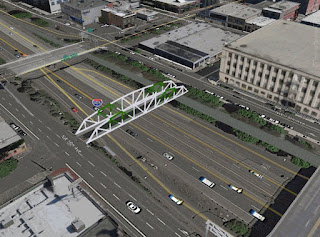Over time, the surrounding expanse of 15 to 20-story buildings has diminished the Park Place's ascendant appearance. When describing where I lived to a talented local scholar, he recognized my residence as "the wedge." If stolid in disposition, Park Place occupies an optimal site with stellar pedestrian connections. At the ground floor on the building's southern end, a restaurant extends to a 50-foot wide walkway that borders Jamison Park. The benches lining this linear space are ideal for meeting friends and genial discussions. When seeking repose, I find a bench that faces away from the park with a view of the lushly planted interior walkway between the tower and the line of low rise townhomes.
This half-block passage exemplifies how public and private space can merge into an aesthetic delight. Lined with birch trees, it is bordered by a profusion of vegetation. Flowering plants adorn the townhome balconies and brighten this idyllic refuge people use to escape the summer cacophony of Jamison Park. I have regular hellos and quick conversations here, while in the winter, when the sun sets by 5 p.m., I conclude my nightly walk at its entrance. I take in the spurge of lights framing the walkway and the white expanse of the Metropolitan, a 20-story tower that terminates the view. Uplifted by this respite, I shoulder the darkness aside for the rest of the evening.
 |
| View to Metro in Winter |
The balcony's most viserceal experience is at sunset. The sky is usually awash in hues of purple, blue, and gray, but in the autumn it takes a different turn. Giant streaks of orange and brilliant yellow command the horizon, reminiscent of the tones and shapes that fill Thomas Cole’s painting, The Savage State. Cole believed views of sublime nature—the grand and awesome spectacle humans could never replicate—unlocked our spiritual moorings. In the midst of a city I revel in the sky’s primeval display, a transcendent experience that enlivens a too often insular existence.
The balcony is where private life is exposed to public view. I have tried to make a convivial statement in the small 4-foot by 9-foot space. Planters filled with native grasses and indigenous firs stand on each end, leaving enough room for two chairs and a small table. A stone Japanese garden vase with flowers adds a spate of color. The final accruement is a small marble Buddha grounded on a circle of recycled timber. My oasis is scant, but ensuring that this bit of nature thrives enhances my well-being. The mix of plants, stone, and furniture also extends the boundary of my unit, which helps lessen the claustrophobia endemic to high-density developments.
The balcony also informs the configuration of my residence. Indoor plants harmonize with the sturdy outdoor specimens to diffuse distinctions between inside and outside. Vibrant abstract paintings line the walls at the far end of the unit. Their vivacity flows into a series of increasingly formal works that terminate at the entrance to the balcony. The colors, however, are consistent and they combine to accentuate the view to the western hills. In the late afternoon, light floods the room and its reflection casts an array of golden tones. The amber glow marks the wedding of nature and art, a time when tension falls away and poetic thoughts ensue.
Modulating constrasts into a common aesthetic brings order and beauty to dailty existence. This endeavor is always a challenge, but the close quarters of urban life demands creativity. In return, abandonded neighborhoods like the Pearl District are crafted into an "urban paradise" with a responsive citizenry.
Caring for the spaces we inhabit not only attunes us to our surroundings, it envokes a sense of place and attachment to others. In the process, we build social capital and gain the confidence to join others in engaging the wider world. Just as in personal relationships, fear of failure dissipates when we advance a cause more important than ourselves.
Cooperation directs the survival instinct, it is why humans not only evolved but flourished. It is no different in our effort to master the city. For humans to reach their potential, only a common effort will make cities both efficient and transcendent. Then we can truly lay claim to paradise.
 |
| Thomas Cole, The Savage State |
The balcony also informs the configuration of my residence. Indoor plants harmonize with the sturdy outdoor specimens to diffuse distinctions between inside and outside. Vibrant abstract paintings line the walls at the far end of the unit. Their vivacity flows into a series of increasingly formal works that terminate at the entrance to the balcony. The colors, however, are consistent and they combine to accentuate the view to the western hills. In the late afternoon, light floods the room and its reflection casts an array of golden tones. The amber glow marks the wedding of nature and art, a time when tension falls away and poetic thoughts ensue.
 |
| Merging of inside and outside space |
Modulating constrasts into a common aesthetic brings order and beauty to dailty existence. This endeavor is always a challenge, but the close quarters of urban life demands creativity. In return, abandonded neighborhoods like the Pearl District are crafted into an "urban paradise" with a responsive citizenry.
Caring for the spaces we inhabit not only attunes us to our surroundings, it envokes a sense of place and attachment to others. In the process, we build social capital and gain the confidence to join others in engaging the wider world. Just as in personal relationships, fear of failure dissipates when we advance a cause more important than ourselves.
Cooperation directs the survival instinct, it is why humans not only evolved but flourished. It is no different in our effort to master the city. For humans to reach their potential, only a common effort will make cities both efficient and transcendent. Then we can truly lay claim to paradise.







